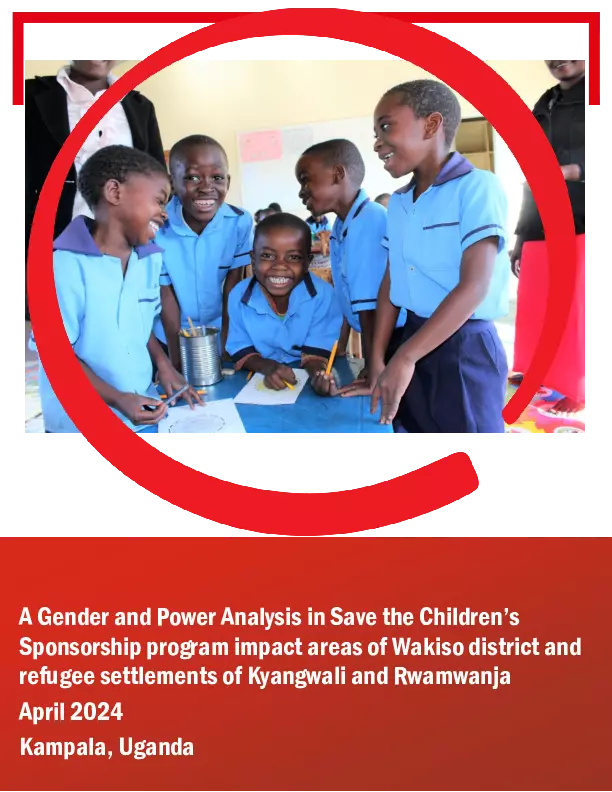
Study: Research
A Gender and Power Analysis in Save the Children’s Sponsorship program impact areas, Uganda, 2024
Publication year:
2024
English
Format:
PDF (1.7 MiB)
Publisher:
Save the Children International,Save the Children Uganda
Save the Children (SC) is implementing a sponsorship programme in both development and humanitarian settings in Uganda. The program operates in Wakiso district in Central Uganda and the refugee settlements of Kyangwali and Rwamwanja in western Uganda. The Sponsorship program is comprised of four core programs, one non-core program, and two cross cutting programs. The core programs are Basic Education (BE), Early Childhood Care and Development (ECCD), School Health and Nutrition (SHN) and Adolescent Development (AD). The non-core program is livelihoods, while the two cross-cutting programs are Community Capacity Strengthening and Child Protection.
A Gender and Power Analysis of the sponsorship programme was conducted to generate data that will help to understand the gender-age differences to ensure that the sponsorship program tackles gender inequalities and discrimination among boys and girls, men and women.
The Gender and Power Analysis adopted a mixed method approach utilizing both quantitative and qualitative methods of data collection. We employed the community-based survey and the school-based survey. Both designs employed a two-stage cluster sampling design, with clustering on the villages (for household survey) or schools (for school-based survey). This approach was largely applied to the community-based survey.
Gender Roles Responsibilities, & Time Use: There is high awareness and adherence to the gender division of labour and expectations. Distinct gender division of labour among women men, boys, and girls at the household level was noted across all study areas.
Power and Decision-Making at Household level: Decision making on different aspects (such as land, finances, means of transport, communication) is still dominated by the male with more men making independent decisions than women, girls, and children.
Access to services: Most adolescents do not have access to services in the communities, including transport (65.0%), job opportunities (88.4%), infrastructure (87.7%), social security (85.3%), safety or security (78.9%), education services (94.9%), and health services (94.1%).
Awareness of the youth groups supported by Save the Children: Most adolescents were aware of the existing youth groups that are supported by Save the Children (57.1%), even though most were not members to any youth group (53.9%), but majority belonged to a social network (68.1%).
Stakeholders engaged in promoting gender equality: The Government of Uganda has institutionalized several gender and child protection instruments aimed at promoting gender equality and inclusion. Several stakeholders including government institutions, CSO and community-level child protection structures, and cultural and religious leaders are engaged in promoting gender equality and inclusion.
It is important the program continues to draw on the Gender Equality and Social Inclusion (GESI) framework given its usefulness in helping different stakeholders to have a clear understanding of gender equality, social inclusion/ exclusion as well as discriminatory practices.
Read full abstract
View & Download
Document information
Format
Content type
Country
Region
Topics
Rights
© Author/Publisher
Found a mistake? Help us improve!
If you have noticed a document assigned to the wrong author or any other inaccuracies, let us know! Your feedback helps us keep our data accurate and useful for everyone.
Share
Link
